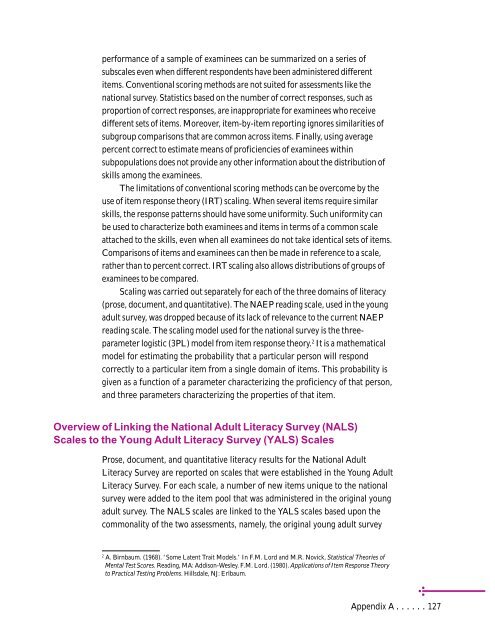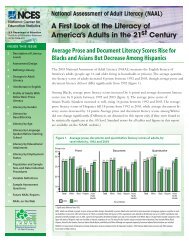Adult Literacy in America - National Center for Education Statistics ...
Adult Literacy in America - National Center for Education Statistics ...
Adult Literacy in America - National Center for Education Statistics ...
You also want an ePaper? Increase the reach of your titles
YUMPU automatically turns print PDFs into web optimized ePapers that Google loves.
per<strong>for</strong>mance of a sample of exam<strong>in</strong>ees can be summarized on a series of<br />
subscales even when different respondents have been adm<strong>in</strong>istered different<br />
items. Conventional scor<strong>in</strong>g methods are not suited <strong>for</strong> assessments like the<br />
national survey. <strong>Statistics</strong> based on the number of correct responses, such as<br />
proportion of correct responses, are <strong>in</strong>appropriate <strong>for</strong> exam<strong>in</strong>ees who receive<br />
different sets of items. Moreover, item-by-item report<strong>in</strong>g ignores similarities of<br />
subgroup comparisons that are common across items. F<strong>in</strong>ally, us<strong>in</strong>g average<br />
percent correct to estimate means of proficiencies of exam<strong>in</strong>ees with<strong>in</strong><br />
subpopulations does not provide any other <strong>in</strong><strong>for</strong>mation about the distribution of<br />
skills among the exam<strong>in</strong>ees.<br />
The limitations of conventional scor<strong>in</strong>g methods can be overcome by the<br />
use of item response theory (IRT) scal<strong>in</strong>g. When several items require similar<br />
skills, the response patterns should have some uni<strong>for</strong>mity. Such uni<strong>for</strong>mity can<br />
be used to characterize both exam<strong>in</strong>ees and items <strong>in</strong> terms of a common scale<br />
attached to the skills, even when all exam<strong>in</strong>ees do not take identical sets of items.<br />
Comparisons of items and exam<strong>in</strong>ees can then be made <strong>in</strong> reference to a scale,<br />
rather than to percent correct. IRT scal<strong>in</strong>g also allows distributions of groups of<br />
exam<strong>in</strong>ees to be compared.<br />
Scal<strong>in</strong>g was carried out separately <strong>for</strong> each of the three doma<strong>in</strong>s of literacy<br />
(prose, document, and quantitative). The NAEP read<strong>in</strong>g scale, used <strong>in</strong> the young<br />
adult survey, was dropped because of its lack of relevance to the current NAEP<br />
read<strong>in</strong>g scale. The scal<strong>in</strong>g model used <strong>for</strong> the national survey is the threeparameter<br />
logistic (3PL) model from item response theory. 2 It is a mathematical<br />
model <strong>for</strong> estimat<strong>in</strong>g the probability that a particular person will respond<br />
correctly to a particular item from a s<strong>in</strong>gle doma<strong>in</strong> of items. This probability is<br />
given as a function of a parameter characteriz<strong>in</strong>g the proficiency of that person,<br />
and three parameters characteriz<strong>in</strong>g the properties of that item.<br />
Overview of L<strong>in</strong>k<strong>in</strong>g the <strong>National</strong> <strong>Adult</strong> <strong>Literacy</strong> Survey (NALS)<br />
Scales to the Young <strong>Adult</strong> <strong>Literacy</strong> Survey (YALS) Scales<br />
Prose, document, and quantitative literacy results <strong>for</strong> the <strong>National</strong> <strong>Adult</strong><br />
<strong>Literacy</strong> Survey are reported on scales that were established <strong>in</strong> the Young <strong>Adult</strong><br />
<strong>Literacy</strong> Survey. For each scale, a number of new items unique to the national<br />
survey were added to the item pool that was adm<strong>in</strong>istered <strong>in</strong> the orig<strong>in</strong>al young<br />
adult survey. The NALS scales are l<strong>in</strong>ked to the YALS scales based upon the<br />
commonality of the two assessments, namely, the orig<strong>in</strong>al young adult survey<br />
2 A. Birnbaum. (1968). “ Some Latent Trait Models.” In F.M. Lord and M.R. Novick, Statistical Theories of<br />
Mental Test Scores. Read<strong>in</strong>g, MA: Addison-Wesley. F.M. Lord. (1980). Applications of Item Response Theory<br />
to Practical Test<strong>in</strong>g Problems. Hillsdale, NJ: Erlbaum.<br />
Appendix A ......127



